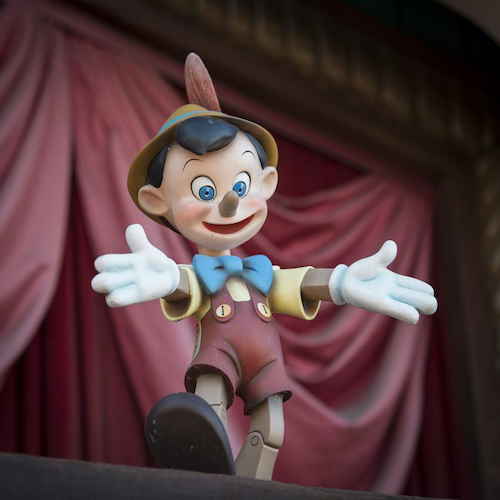Disneyland Paris Shares History of Les Voyages de Pinocchio (The Voyages of Pinocchio) Ride
Hi everyone!
To mark the recent release of the live-action retelling of Pinocchio on Disney+, we take a look at the Fantasyland attraction dedicated to the ‘little wooden head’. Like Robert Zemeckis’ film, Les Voyages de Pinocchio is a vibrant homage to the 1940 classic, which also has its share of surprises …
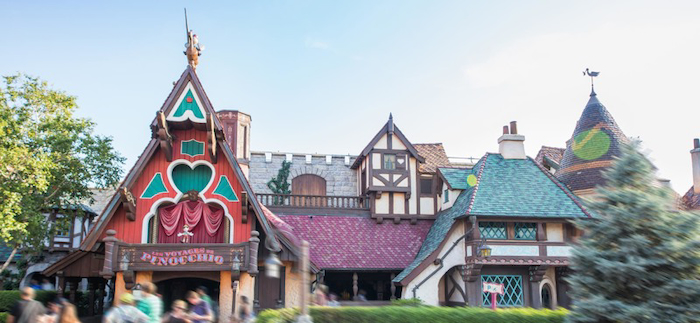
PINOCCHIO’S TYROL
Les Voyages de Pinocchio is located alongside Blanche-Neige et les Sept Nains in the Germanic part of Fantasyland – a fitting location considering that Walt Disney moved his story from author Carlo Collodi’s native Tuscany to Tyrol. The Disney Imagineers endeavoured to recreate the film’s settings in architecture, taking care to preserve the original look. As you approach the attraction, you feel as if you are really stepping into the animation!
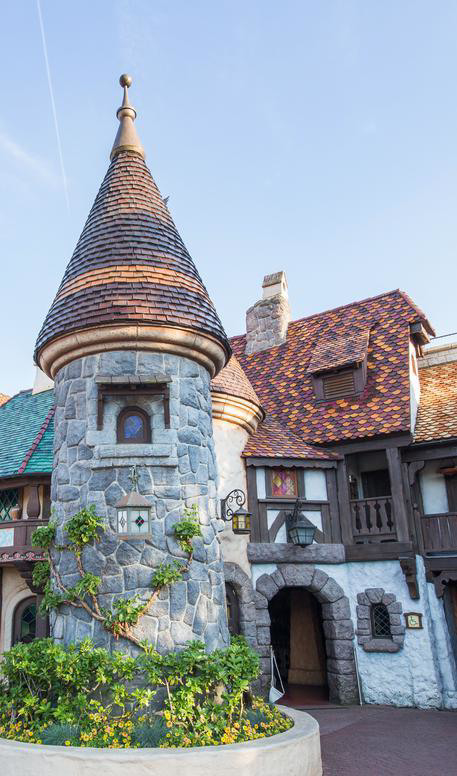
A COLOURFUL TRIBUTE
The design of the scenic route inside the ride also makes a point of paying tribute to the aesthetics of the film, particularly in terms of colour. Artistic director Paul C. Torrigino studied the 1940 masterpiece in detail. This allowed him to get as close as possible to the original hues, while taking the specificities of black light into account and giving the nearly 300 set elements a magical luminescence.
As for the characters, Jiminy’s small size meant that the artists had to be particularly precise in rendering his various expressions.
Meanwhile, the white light, used at the beginning and end of the adventure, allowed the painters to integrate numerous additional details, again inspired by the film, such as on Pinocchio’s costume in the final scene.
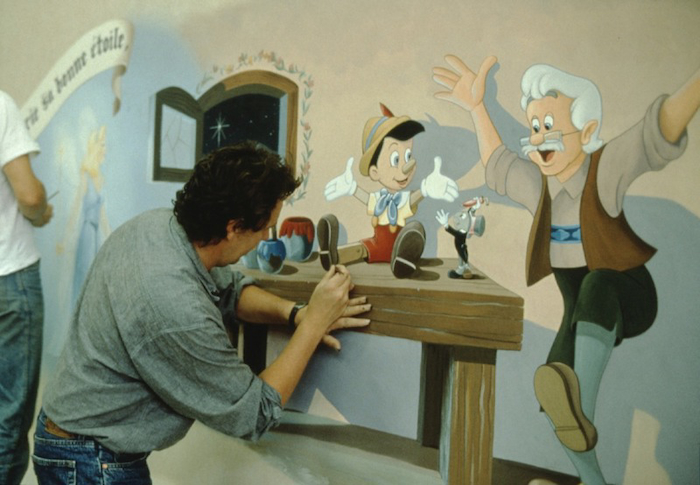
A MUSICAL JOURNEY
Music plays a major role in telling the story of these adventures and immersing guests in the film’s atmosphere. The iconic song ‘Hi-Diddle Di Di’ is the attraction’s common thread, guiding Pinocchio like a leitmotif throughout his adventures. It is first sung by Pinocchio in the Stromboli Theatre (in place of “I’ve got no strings” in the film), then played instrumentally on Pleasure Island, first on the barrel organ, typical of funfairs, then as a ragtime in Tobacco Road, before giving way to a darker arrangement in the Eight Ball pool hall and in the scene with the caged donkeys.
The Blue Fairy theme appears alongside Stromboli’s cage, evoking her magical contribution to our rescue. She reappears at the end of the ride, just after “When you wish upon a star’, as we enter Gepetto’s workshop and she makes a surprise visit to bring Pinocchio back to life.
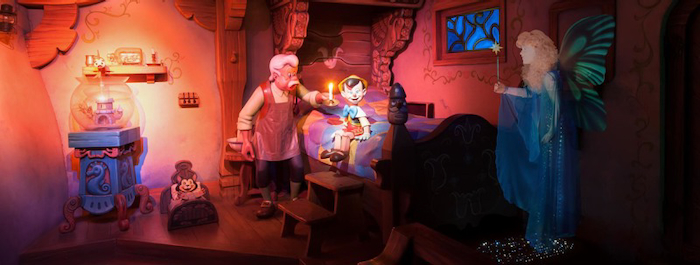
JOURNEY COMPANIONS
One of the unique features of the original film was that the narrator – Jiminy Cricket – was also one of the characters in the plot. As historian J.B. Kaufman points out in his reference book on the history of Pinocchio, Walt Disney was thus echoing Sacha Guitry’s film The Story of a Cheat, released in the US in September 1938. In it the main character was able to address the audience in the middle of a scene (a feature that was also recently repeated in the series She-Hulk: Attorney at Law). In the attraction, Jiminy also speaks directly to the guests, transforming them from spectators to Pinocchio’s journey companions.
To get guests even more involved in the story, the Imagineers had the idea of starting this adventure ‘in media res’ (literally ‘in the midst of things’), a literary and theatrical device aimed at bringing the spectator directly into the action, without any prelude. In fact, as the miniature stage and the crimson curtain over the entrance to the building suggest, our journey through the theatre begins with the first (and only) performance of Pinocchio in the Stromboli puppet theatre.
AN EYE FOR DETAIL
But that’s not all! While Robert Zemeckis’ film is a new vision of the story, notably through the addition of new elements such as the character of Sophie the Seagull, the attraction integrates several details that were imagined during the conception of the 1940 classic, but not retained in the final version. For example, the scenery in the first part of Pleasure Island, with the candy canes, gingerbread and other sweets, comes from a previous version of the scene in the animated film. However, Walt ultimately decided to turn it into a place where all life’s rules are broken, just like Tobacco Road.
Another element that was removed from the film but can be found in the attraction is the policeman. According to J.B. Kaufman, Gepetto asked him to find his son in the pouring rain in a previous version, but the policeman remained silent and motionless, just staring at him intently. It is this policeman that we find in the attraction, in the middle of Pleasure Island, and he stares at us just like the original character, without ever saying a word or lifting a finger!
Now that’s what I call a professional ‘conscience’!
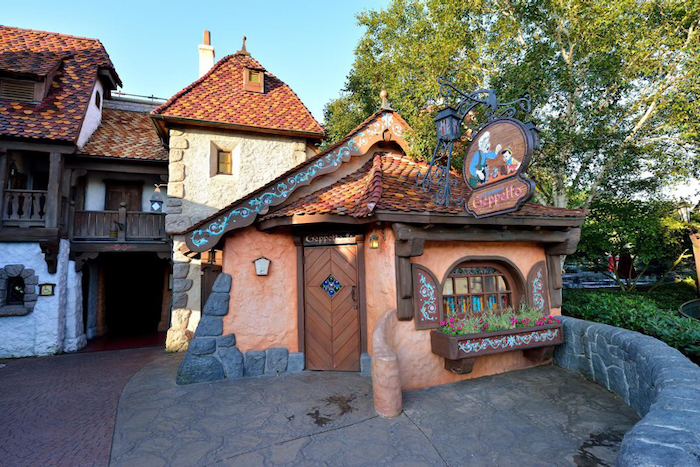
You can also find the world of Pinocchio in the La Bottega di Geppetto boutique, which faithfully recreates the wood sculptor’s workshop of the 1940 Classic, while the restaurant Au Chalet de la Marionnette takes up the emblematic scenes from the animated film on its walls and in its decoration, to the point of immersing yourself in the stomach of Monstro the whale in the part of the establishment which opens onto Adventureland!
Disneyland Paris has also celebrated Pinocchio in parades such as the Disney Parade (1992), the Main Street Electrical Parade (1992 and 1998), the Disney Cinema Parade (2002) and Disney’s Once Upon a Dream Parade (2007).
Whether it’s in the alleys of our Parks or on Disney+, there are a hundred and one opportunities to Wish Upon a Star!
